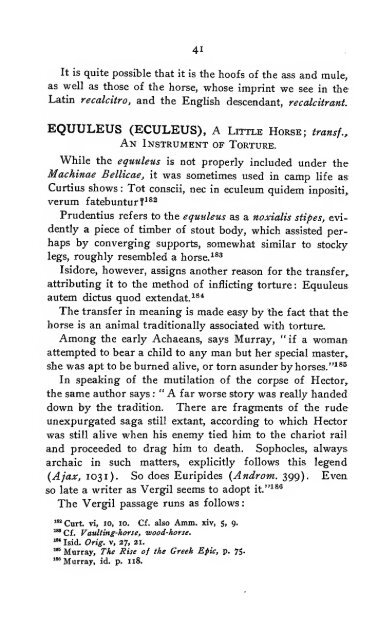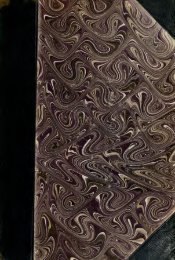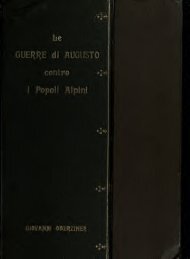Figurative uses of animal names in Latin and their ... - mura di tutti
Figurative uses of animal names in Latin and their ... - mura di tutti
Figurative uses of animal names in Latin and their ... - mura di tutti
Create successful ePaper yourself
Turn your PDF publications into a flip-book with our unique Google optimized e-Paper software.
41<br />
It is quite possible that it is the ho<strong>of</strong>s <strong>of</strong> the ass <strong>and</strong> mule,<br />
as well as those <strong>of</strong> the horse, whose impr<strong>in</strong>t we see <strong>in</strong> the<br />
Lat<strong>in</strong> recalcitro, <strong>and</strong> the English descendant, recalcitrant.<br />
EQUULEUS (ECULEUS), A Little Horse; transf..<br />
An Instrument <strong>of</strong> Torture.<br />
While the equuleus is not properly <strong>in</strong>cluded under the<br />
Mach<strong>in</strong>ae Bellicae, it was sometimes used <strong>in</strong> camp life as;<br />
Curtius shows : Tot conscii, nee <strong>in</strong> eculeum quidem <strong>in</strong>positi,<br />
verum fatebuntur?^^^<br />
Prudentius refers to the equuleus as a noxialis stipes, evi-<br />
dently a piece <strong>of</strong> timber <strong>of</strong> stout body, which assisted per-<br />
haps by converg<strong>in</strong>g supports, somewhat similar to stocky<br />
legs, roughly resembled a horse. ^**<br />
Isidore, however, assigns another reason for the transfer,<br />
attribut<strong>in</strong>g it to the method <strong>of</strong> <strong>in</strong>flict<strong>in</strong>g torture : Equuleus<br />
autem <strong>di</strong>ctus quod extendat.-'^*<br />
The transfer <strong>in</strong> mean<strong>in</strong>g is made easy by the fact that the<br />
horse is an <strong>animal</strong> tra<strong>di</strong>tionally associated with torture.<br />
Among the early Achaeans, says Murray, " if a woman<br />
attempted to bear a child to any man but her special master,<br />
she was apt to be burned alive, or torn asunder by horses."^*^<br />
In speak<strong>in</strong>g <strong>of</strong> the mutilation <strong>of</strong> the corpse <strong>of</strong> Hector,<br />
" A far worse story was really h<strong>and</strong>ed<br />
the same author says :<br />
down by the tra<strong>di</strong>tion. There are fragments <strong>of</strong> the rude<br />
unexpurgated saga still extant, accord<strong>in</strong>g to which Hector<br />
was still alive when his enemy tied him to the chariot rail<br />
<strong>and</strong> proceeded to drag him to death. Sophocles, always<br />
archaic <strong>in</strong> such matters, explicitly follows this legend<br />
{Ajax, 1031). So does Euripides {Androm. 399). Evea<br />
so late a writer as Vergil seems to adopt it."^*®<br />
The Vergil passage runs as follows:<br />
"^ Curt, vi, 10, 10. Cf. also Amm. xiv, 5, 9.<br />
"°Cf. Vault<strong>in</strong>g-horse, wood-horse.<br />
"* Isid. Orig. v, 27, 21.<br />
"" Murray, The Rise <strong>of</strong> the Greek Epic, p. 75.<br />
' Murray, id. p. 118.



![Das Kriegswesen der Alten [microform] - mura di tutti](https://img.yumpu.com/21606999/1/167x260/das-kriegswesen-der-alten-microform-mura-di-tutti.jpg?quality=85)








